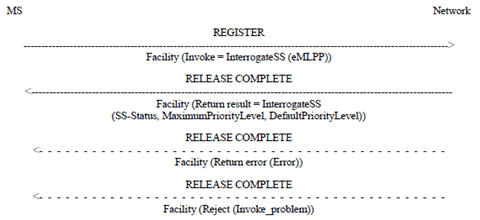TS 24.067
enhanced Multi-Level Precedence and Pre-emption service (eMLPP)
V18.0.0 (PDF)
2024/03 … p.
V17.0.0
2022/03 15 p.
V16.0.0
2020/06 15 p.
V15.0.0
2018/06 15 p.
V14.0.0
2017/03 15 p.
V13.0.0
2015/12 15 p.
V12.0.0
2014/09 15 p.
V11.0.0
2012/09 15 p.
V10.0.0
2011/04 15 p.
V9.0.0
2009/12 15 p.
V8.0.0
2008/12 15 p.
V7.0.0
2007/07 15 p.
V6.0.0
2005/01 15 p.
V5.0.0
2002/06 15 p.
V4.1.0
2001/06 15 p.
V3.2.0
2001/06 15 p.
GSM Rel-98 v7.0.1
2000/01 14 p.
GSM Rel-97 v6.0.1
1998/11 14 p.
GSM Rel-96 v5.0.1
2000/11 16 p.
- Rapporteur:
- Mr. Schmitt, Peter
Huawei Tech.(UK) Co.. Ltd
Content for TS 24.067 Word version: 17.0.0
1 Scope p. 5
The present document specifies the procedures used at the radio interface (Reference point Um for GSM and Reference point Uu for UMTS as defined in TS 24.002) for normal operation, invocation, registration and interrogation of the enhanced Multi-Level Precedence and Pre-emption Service (eMLPP) supplementary service. Provision and withdrawal of supplementary services is an administrative matter between the mobile subscriber and the service provider and cause no signalling on the radio interface.
In TS 24.010 the general aspects of the specification of supplementary services at the layer 3 radio interface are given.
TS 24.080 specifies the formats and coding for the supplementary services.
Definitions and descriptions of supplementary services are given in TS 22.004 and TS 22.08x and22.09x -series. TS 22.067 is related specially to eMLPP.
Technical realization of supplementary services is described in TS 23.011 and TS 23.08x and 23.09x -series.
TS 23.067 is related specially to eMLPP.
The procedures for Call Control, Mobility Management at the layer 3 radio interface are defined in TS 24.007 and TS 24.008.
The procedure for Radio Resource management at layer 3 radio interface is defined in TS 44.018 and TS 25.331.
2 References p. 5
The following documents contain provisions which, through reference in this text, constitute provisions of the present document.
- References are either specific (identified by date of publication, edition number, version number, etc.) or non-specific.
- For a specific reference, subsequent revisions do not apply.
- For a non-specific reference, the latest version applies. In the case of a reference to a 3GPP document (including a GSM document), a non-specific reference implicitly refers to the latest version of that document in the same Release as the present document.
[1]
GSM 01.04: "Digital cellular telecommunications system (Phase 2+); Abbreviations and acronyms".
[2]
TS 22.004: "General on supplementary services".
[3]
TS 22.067: "enhanced Multi-Level Precedence and Pre-emption service (eMLPP) - Stage 1".
[4]
TS 22.081: "Line identification supplementary services - Stage 1".
[5]
TS 22.082: "; Call Forwarding (CF) supplementary services - Stage 1".
[6]
TS 23.083: "Call Waiting (CW) and Call Hold (HOLD) supplementary services - Stage 1".
[7]
TS 22.084: "MultiParty (MPTY) supplementary services - Stage 1".
[8]
TS 22.085: "; Closed User Group (CUG) supplementary services - Stage 1".
[9]
TS 22.086: "Advice of Charge (AoC) Supplementary Services - Stage 1".
[10]
TS 22.088: "Call Barring (CB) supplementary services - Stage 1".
[11]
TS 22.090: "Stage 1 description of Unstructured Supplementary Service Data (USSD)".
[12]
[13]
TS 22.011: "Technical realization of supplementary services".
[14]
TS 23.067: "enhanced Multi-Level Precedence and Pre-emption service (eMLPP) - Stage 2".
[15]
TS 43.068: "Voice Group Call Service (VGCS) - Stage 2".
[16]
TS 43.069: "Voice Broadcast Service (VBS) - Stage 2".
[17]
TS 23.081: "Line identification supplementary services - Stage 2".
[18]
TS 23.082: "Call Forwarding (CF) supplementary services - Stage 2".
[19]
TS 23.083: "Call Waiting (CW) and Call Hold (HOLD) supplementary services - Stage 2".
[20]
TS 23.084: "MultiParty (MPTY) supplementary services - Stage 2".
[21]
TS 23.085: "Closed User Group (CUG) supplementary services - Stage 2".
[22]
[23]
TS 23.088: "Call Barring (CB) supplementary services - Stage 2".
[24]
TS 23.090: "Unstructured supplementary services operation - Stage 2".
[25]
TS 23.091: "Explicit Call Transfer (ECT) supplementary service - Stage 2".
[26]
TS 24.002: "GSM Public Land Mobile Network (PLMN) access reference configuration".
[27]
TS 24.007: "Mobile radio interface signalling layer 3; General aspects".
[28]
TS 24.008: "Mobile radio interface layer 3 specification".
[29]
TS 24.010: "Mobile radio interface layer 3 Supplementary services specification; General aspects".
[30]
TS 24.080: "Mobile radio interface layer 3 supplementary services specification Formats and coding".
[31]
TS 21.905: "3G Vocabulary"
[32]
TS 25.331: "Mobile radio interface layer 3 specification; RRC Protocol Specification"
[33]
TS 44.018: "Digital cellular telecommunications system (Phase 2+); Mobile radio interface layer 3 specification; Radio Resource Control Protocol"
3 Definitions and abbreviations p. 6
3.1 Definitions p. 6
3.2 Abbreviations p. 6
Abbreviations used in the present document are listed in GSM 01.04 and TR 21.905.
For the purposes of the present document, the following abbreviations apply:
eMLPP
enhanced MLPP
MLPP
Multi-Level Precedence and Pre-emption
VBS
Voice Broadcast Service
VGCS
Voice Group Call Service
4 enhanced Multi-Level Precedence and Pre-emption (eMLPP) p. 7
4.1 Normal operation p. 7
4.1.1 Mobile originated calls p. 7
The mobile station can indicate the priority of each call initiated. If no priority is indicated by the user or a non-compatible mobile station is used then the default priority level shall be applied which is stored in the VLR. The selection of priority shall be an MMI function.
For mobile originated calls in GSM mode in GSM mode, the corresponding message flows are shown in Figure 1.1.
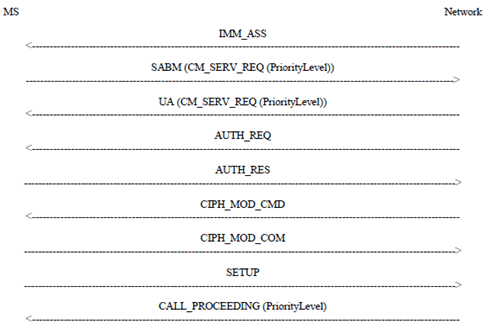
Figure 1.1: Signalling information required for the prioritisation at mobile originating call establishment (in GSM mode)
(⇒ copy of original 3GPP image)
(⇒ copy of original 3GPP image)
IMM_ASS:
Standard GSM Radio resource management message which is sent if no RR connection was already established.
SABM (CM_SERV_REQ (PriorityLevel)):
L3-MM CM SERVICE REQUEST where the priority level information element is provided in addition if a priority selection is performed by the user. In case of no priority selection or use of a non-compatible mobile station the mobile station shall send a service request message without priority level information element and the network shall apply a default priority to the request. The message may be piggybacked in a SABM if no RR connection was already established.
UA (CM_SERV_REQ (PriorityLevel):
Standard message to acknowledge the layer 2 link which is sent if no RR connection was already established. The priority level is the same as received by the network.
AUTH_REQ:
Standard message which is sent if the network applies authentication as shown in Figure 1.1. If not, the network will sent a standard CM_SERVICE_ACCEPT message.
AUTH_RES:
Standard message which is sent if the network applies authentication.
CIPH_MOD_CMD:
Standard message which is sent if the network applies ciphering as shown in Figure 1.1.
CIPH_MOD_COM:
Standard message which is sent if the network applies ciphering.
SETUP:
Standard message.
CALL_PROCEEDING:
The network shall include the assigned priority level in a CALL_PROCEEDING, when the network supports priority.
For mobile originated calls in UMTS mode, the corresponding message flows are shown in Figure 1.2.
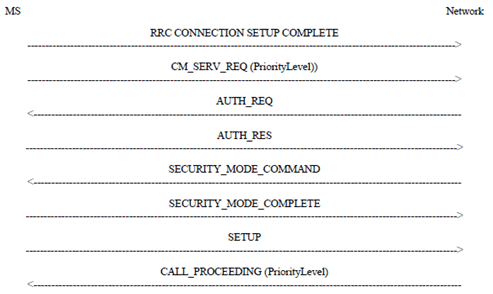
Figure 1.2: Signalling information required for the prioritisation at mobile originating call establishment (in UMTS mode)
(⇒ copy of original 3GPP image)
(⇒ copy of original 3GPP image)
RRC CONNECTION SETUP COMPLETE:
Standard UMTS Radio resource management message which is sent to confirm the establishment of the RRC Connection by the UE.
CM_SERV_REQ (PriorityLevel):
L3-MM CM SERVICE REQUEST where the priority level information element is provided in addition if a priority selection is performed by the user. In case of no priority selection or use of a non-compatible mobile station the mobile station shall send a service request message without priority level information element and the network shall apply a default priority to the request.
AUTH_REQ:
Standard message.
AUTH_RES:
Standard message.
SECURITY_MODE_COMMAND:
Standard message.
SECURITY_MODE_COMPLETE:
Standard message.
SETUP:
Standard message.
CALL_PROCEEDING:
The network shall include the assigned priority level in a CALL_PROCEEDING message. If the MS has indicated the priority in the CM_SERVICE_REQUEST message and if no priority level is included in the CALL_PROCEEDING message, then the MS shall assume that the network doesn't support priority.
4.1.2 Mobile terminated calls p. 9
For a mobile terminated call the priority level is indicated by the calling subscriber if MLPP is used. The mobile station may be paged in the normal manner, but with the paging messages also containing the priority level of the call. In addition, the priority level shall be included in the set-up message.

Figure 2: Signalling information required for the prioritisation at mobile terminating call establishment without called-party pre-emption.
(⇒ copy of original 3GPP image)
(⇒ copy of original 3GPP image)
PAG_REQ:
Paging message including the related priority level to be applied. (GSM only)
SETUP:
Modified SETUP message with an indication of the priority level.
4.1.3 Called party pre-emption for mobile terminated calls p. 9
In the case where the called subscriber has a subscription for eMLPP and for CW, the mobile station shall be informed of the priority of the new call together with the CW indication. On reception of the set-up message the compatible mobile station decides on called party pre-emption. If called party pre-emption applies, the mobile station shall automatically accept the waiting call and send a hold message to the network. If a hold acknowledge is received, the waiting call is accepted. If a hold reject is received for any reason, e.g. there is no subscription for hold, the other call shall be released and the waiting call accepted. If the ongoing call is not a TS11 call, the mobile station should not send a hold message to the network but release the call and accept the waiting call.
If no pre-emption applies or the called party is using a non compatible mobile station, CW will be used as normal.

Figure 3: Signalling information required for the called-party pre-emption in case of use of a compatible mobile station
(⇒ copy of original 3GPP image)
(⇒ copy of original 3GPP image)
SETUP:
Modified SETUP message with an indication of the priority level.
4.1.4 Group call or broadcast call, calling mobile station (GSM only) p. 9
Within each set of voice group call or voice broadcast call attributes stored in the GCR as defined in TS 43.068 and TS 43.069, respectively, a priority level is included if eMLPP is applied. The priority level will be provided by the GCR to the MSC together with the call attributes.
For VGCS or VBS establishment, the calling mobile station may indicate a priority level in the service request as in subclause 4.1.1. This priority level can be applied for the dedicated link of the calling mobile station as long as no different priority level in provided by the GCR. If this happens, the priority level provided by the GCR shall also be applied to the dedicated link of the calling mobile station.
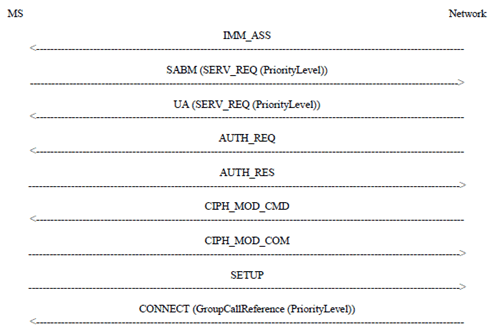
Figure 4: Signalling information between the network and the calling mobile station required for the prioritisation in case of a VGCS or VBS call
(⇒ copy of original 3GPP image)
(⇒ copy of original 3GPP image)
IMM_ASS:
Standard message which is sent if no RR connection was already established.
SABM (SERV_REQ (PriorityLevel)):
L3-MM CM SERVICE REQUEST where the priority level information element is provided in addition if a priority selection is performed by the user. In case of no priority selection or use of a non-compatible mobile station the mobile station shall send a service request message without priority level information element and the network shall apply a default priority to the request. The message may be piggybacked in a SABM if no RR connection was already established.
UA (SERV_REQ (PriorityLevel)):
Standard message to acknowledge the layer 2 link which is sent if no RR connection was already established. The priority level is the same as received by the network.
AUTH_REQ:
Standard message which is sent if the network applies authentication as shown in Figure 4. If not, the network will sent a standard CM_SERVICE_ACCEPT message.
AUTH_RES:
Standard message which is sent if the network applies authentication.
CIPH_MOD_CMD:
Standard message which is sent if the network applies ciphering as shown in Figure 4.
CIPH_MOD_COM:
Standard message which is sent if the network applies ciphering.
SETUP:
Standard message.
CONNECT:
Information to the mobile station that the VGCS or VBS call is established with the related group or broadcast call reference as the connected number. The group or broadcast call reference includes the priority level applied for the group or broadcast call in the network. This priority level can be different to the one indicated in the CM_SERVICE_REQUEST.
4.1.5 Group or broadcast call, called mobile stations (GSM only) p. 11
Within each set of voice group call or voice broadcast call attributes stored in the GCR as defined in TS 43.068 and TS 43.069, respectively, a priority level is included if eMLPP is applied. The priority level will be provided by the GCR to the MSC together with the call attributes.
The priority level shall be indicated together with the related notification messages and treated in the mobile station as defined in TS 43.068 and TS 43.069, respectively.

Figure 5: Signalling information between the network and the called mobile stations required for the prioritisation in case of a VGCS or VBS call
(⇒ copy of original 3GPP image)
(⇒ copy of original 3GPP image)
NOTIFICATION:
L3 RR message NOTIFICATION/NCH_TYPE1 or NOTIFICATION/NCH_TYPE2 or NOTIFICATION/FACCH or NOTIFICATION/SACCH containing a group call reference or broadcast call reference of a notified voice group or broadcast call which includes a related priority level for that call.
4.2 Registration p. 11
The default eMLPP priority level has to be registered in the network:
An eMLPP registration request from a mobile user shall include the SS-Code of the eMLPP service and the default priority level.
If the registration is successful, the default eMLPP priority level will be registered. The network will then send a return result indicating acceptance of the request, including the default eMLPP priority level.
If the system cannot accept a registration request, a corresponding error indication is returned to the served mobile subscriber that eMLPP registration was not successful. Error values are specified in GSM 04.80.
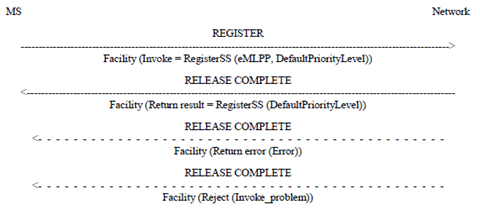
4.3 Erasure p. 11
A previous registration can be erased in one of two ways:
- the subscriber can register information for eMLPP for a new default priority level, thus causing the previous registration of eMLPP to be overridden;
- all information is erased as a result of withdrawal of the supplementary service (administrative handling).
4.4 Activation, deactivation p. 12
Activation and deactivation of the supplementary service enhanced Multi-Level Precedence and Pre-emption are not applicable.
4.5 Interrogation p. 12
The interrogation procedure enables the mobile subscriber to obtain information about data stored in the PLMN. The eMLPP service subscriber may interrogate the maximum priority level he can use and the actual default priority level.
If the service is provisioned, the network shall sent a return result including the SS-Status parameter and the maximum priority level which the service subscriber is allowed to use and the actual default priority level.
If the service is not provisioned, the network shall send a return result including the SS-Status parameter.
